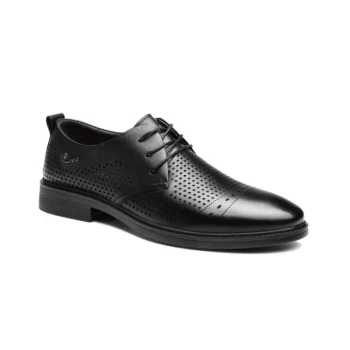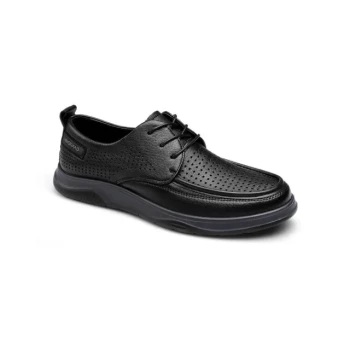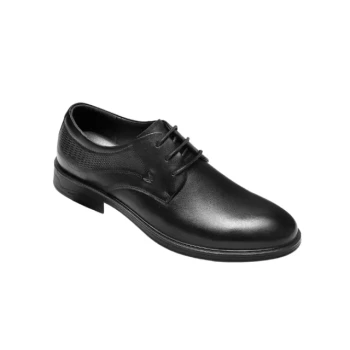At its core, brogueing is the pattern of decorative perforations punched into the leather of a dress shoe. These small holes and serrated edges, originally designed for draining water from shoes in the marshlands of Scotland and Ireland, are now a purely aesthetic detail. The amount and style of this decoration directly influence the shoe's formality.
Brogueing is a visual language for dress shoes. While it began as a practical feature, it now serves as a key indicator of formality—the more intricate the brogueing, the less formal the shoe.
The Journey from Function to Fashion
The evolution of brogueing is a perfect example of how utilitarian design can transform into a sophisticated style element. Understanding its origin helps clarify its modern role.
The Practical Origins
The term "brogue" comes from the Gaelic word bróg, meaning shoe. These early shoes were worn by farmers in rugged, wet terrain. The perforations were a functional necessity, allowing water to drain out of the shoe as the wearer walked through bogs and marshes.
Modern Decorative Symbolism
Today, those functional holes are entirely decorative. They serve to break up the smooth, plain surface of the leather, adding visual texture and character. This added character is what reduces a shoe's formality, making it feel more relaxed and rustic compared to its unadorned counterparts.
Decoding the Levels of Brogueing
The extent and pattern of the perforations define the type of brogue. The primary styles are distinguished by the shape of the toe cap and the amount of decoration.
Full Brogue (The "Wingtip")
This is the most heavily decorated and recognizable style. It is defined by a pointed toe cap that extends along the sides of the shoe, forming a "W" or wing-like shape. A full brogue features perforations along all of its seams and often includes a decorative pattern, or medallion, on the toe.
Half Brogue (The "Semi-Brogue")
The half brogue is more restrained. It features a straight toe cap, not a pointed one, and has perforations along the cap's seam as well as a medallion on the toe. It strikes a balance between the formality of a simpler shoe and the decorative flair of a full brogue.
Quarter Brogue
This is the most formal and minimalist type of brogue. A quarter brogue has a straight toe cap like the half brogue, but the only decoration is a single line of perforations along the cap's seam. There is no medallion on the toe, making it a subtle and elegant choice.
Brogueing vs. Shoe Style: A Critical Distinction
A common point of confusion is thinking "brogue" is a type of shoe. It is not. Brogueing is a decorative detail that can be applied to different shoe constructions, most commonly Oxfords and Derbys.
The Impact on Formality
The fundamental rule is simple: more brogueing equals less formality. A plain-toe Oxford is more formal than a quarter-brogue Oxford. A quarter-brogue Oxford is more formal than a full-brogue "wingtip" Oxford.
Construction Still Matters
The underlying shoe style retains its own level of formality. An Oxford, with its closed lacing system, is inherently more formal than a Derby, which has an open lacing system. Therefore, a quarter-brogue Oxford is more formal than a quarter-brogue Derby. You must consider both the construction and the decoration.
Common Pitfalls to Avoid
The biggest mistake is wearing a heavily brogued shoe to a highly formal event. While a dark brown full brogue might be perfect for a tweed suit or business-casual trousers, it is generally inappropriate for a formal business suit (like navy or charcoal) and certainly for black-tie attire.
Making the Right Choice for Your Goal
Selecting the right level of brogueing depends entirely on the context and your desired impression.
- If your primary focus is maximum formality (boardroom meetings, conservative business): Choose a Quarter Brogue on an Oxford, as its subtle detail adds character without sacrificing seriousness.
- If your primary focus is business-casual versatility (daily office wear, smart social events): The Half Brogue is your most reliable option, perfectly bridging the gap between formal and casual.
- If your primary focus is a relaxed but stylish look (creative workplaces, weekend wear): The Full Brogue or "Wingtip" offers timeless character that pairs exceptionally well with chinos, flannel trousers, and even dark denim.
By understanding the language of brogueing, you can confidently select the precise shoe that complements your outfit and respects the occasion.
Summary Table:
| Brogue Style | Key Feature | Best For |
|---|---|---|
| Full Brogue (Wingtip) | W-shaped toe cap, medallion | Relaxed, stylish look (casual offices, weekends) |
| Half Brogue (Semi-Brogue) | Straight toe cap, medallion | Business-casual versatility (daily office, smart events) |
| Quarter Brogue | Straight toe cap, seam perforations only | Maximum formality (boardrooms, conservative business) |
Ready to Elevate Your Footwear Collection?
As a large-scale manufacturer, 3515 produces a comprehensive range of high-quality dress shoes, including all brogue styles, for distributors, brand owners, and bulk clients. Our expertise ensures you get the perfect balance of style, craftsmanship, and value.
Contact us today to discuss your production needs and discover how we can help you supply exceptional footwear to your market.
Related Products
- Wholesale Breathable Perforated Leather Derby Dress Shoes for Custom Brands
- Wholesale Leather Derby Shoes Manufacturer | Customizable Business & Dress Footwear
- Custom Manufactured Air Cushion Leather Business Shoes for Wholesale
- Wholesale Comfortable Business Casual Shoes Custom Manufacturing
- Wholesale Breathable Perforated Leather Derby Shoes with Modern Comfort Sole
People Also Ask
- What is the importance of understanding different types of leather for shoes? A Guide to Quality & Durability
- How can one identify authentic leather footwear? A Guide to Spotting Genuine vs. Fake
- How should leather shoes be cleaned after each wear? A 60-Second Daily Ritual for Longevity
- What should be known about genuine leather for shoes? Don't Be Misled by the Label
- How does leather compare to other shoe materials in terms of durability and comfort? A Material Guide for Footwear



















